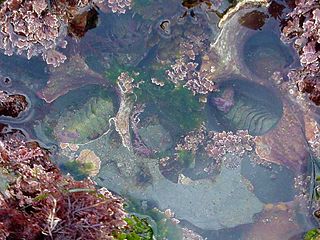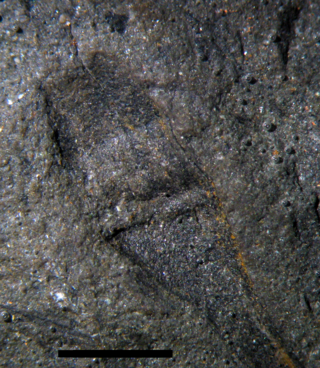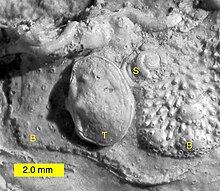
A cladogram is a diagram used in cladistics to show relations among organisms. A cladogram is not, however, an evolutionary tree because it does not show how ancestors are related to descendants, nor does it show how much they have changed, so many differing evolutionary trees can be consistent with the same cladogram. A cladogram uses lines that branch off in different directions ending at a clade, a group of organisms with a last common ancestor. There are many shapes of cladograms but they all have lines that branch off from other lines. The lines can be traced back to where they branch off. These branching off points represent a hypothetical ancestor which can be inferred to exhibit the traits shared among the terminal taxa above it. This hypothetical ancestor might then provide clues about the order of evolution of various features, adaptation, and other evolutionary narratives about ancestors. Although traditionally such cladograms were generated largely on the basis of morphological characters, DNA and RNA sequencing data and computational phylogenetics are now very commonly used in the generation of cladograms, either on their own or in combination with morphology.
An evolutionary radiation is an increase in taxonomic diversity that is caused by elevated rates of speciation, that may or may not be associated with an increase in morphological disparity. A significantly large and diverse radiation within a relatively short geologic time scale is often referred to as an explosion. Radiations may affect one clade or many, and be rapid or gradual; where they are rapid, and driven by a single lineage's adaptation to their environment, they are termed adaptive radiations.
Namacalathus is a problematic metazoan fossil occurring in the latest Ediacaran. The first, and only described species, N. hermanastes, was first described in 2000 from the Nama Group of central and southern Namibia.

Oxyaena is an extinct genus of placental mammals from extinct subfamily Oxyaeninae within extinct family Oxyaenidae, that lived in Europe, Asia and North America during the early Eocene.

Ontogeny and Phylogeny is a 1977 book on evolution by Stephen Jay Gould, in which the author explores the relationship between embryonic development (ontogeny) and biological evolution (phylogeny). Unlike his many popular books of essays, it was a technical book, and over the following decades it was influential in stimulating research into heterochrony, which had been neglected since Ernst Haeckel's theory that ontogeny recapitulates phylogeny had been largely discredited. This helped to create the field of evolutionary developmental biology.

The Mesozoic marine revolution (MMR) refers to the increase in shell-crushing (durophagous) and boring predation in benthic organisms throughout the Mesozoic era, along with bulldozing and sediment remodelling in marine habitats. The term was first coined by Geerat J. Vermeij, who based his work on that of Steven M. Stanley. While the MMR was initially restricted to the Cretaceous, more recent studies have suggested that the beginning of this ecological arms race extends as far back as the Triassic, with the MMR now being considered to have started in the Anisian or the Aalenian. It is an important transition between the Palaeozoic evolutionary fauna and the Modern evolutionary fauna that occurred throughout the Mesozoic.

Strophomenida is an extinct order of articulate brachiopods which lived from the lower Ordovician period to the mid Carboniferous period. Strophomenida is part of the extinct class Strophomenata, and was the largest known order of brachiopods, encompassing over 400 genera. Some of the largest and heaviest known brachiopod species belong to this class. Strophomenids were among the most diverse and abundant brachiopods during the Ordovician, but their diversity was strongly impacted at the Late Ordovician mass extinction. Survivors rediversified into new morphologies in the Silurian, only to be impacted once again at the Late Devonian mass extinction. However, they still survived till the mid Carboniferous.
The Khatyspyt Formation is a Neoproterozoic formation exposed in the Olenëk Uplift of north central Siberia, which contains the only known instance of the Ediacara biota preserved in a limestone bed. The Khatyspyt Formation forms one of the major parts of the Khorbusuonka Group; underlying the Khatyspyt are dolomites of the Mastakh Formation and their overlying red beds; the Turkut Formation overlies the Khatyspyt. The Khatyspyt and part of the overlying Turkut comprise a major shallowing upward marine carbonate sequence. Khatyspytia is named after this formation.

Brachiopods, phylum Brachiopoda, are a phylum of trochozoan animals that have hard "valves" (shells) on the upper and lower surfaces, unlike the left and right arrangement in bivalve molluscs. Brachiopod valves are hinged at the rear end, while the front can be opened for feeding or closed for protection. Two major categories are traditionally recognized, articulate and inarticulate brachiopods. The word "articulate" is used to describe the tooth-and-groove structures of the valve-hinge which is present in the articulate group, and absent from the inarticulate group. This is the leading diagnostic skeletal feature, by which the two main groups can be readily distinguished as fossils. Articulate brachiopods have toothed hinges and simple, vertically oriented opening and closing muscles. Conversely, inarticulate brachiopods have weak, untoothed hinges and a more complex system of vertical and oblique (diagonal) muscles used to keep the two valves aligned. In many brachiopods, a stalk-like pedicle projects from an opening near the hinge of one of the valves, known as the pedicle or ventral valve. The pedicle, when present, keeps the animal anchored to the seabed but clear of sediment which would obstruct the opening.

Aphelops is an extinct genus of hornless rhinocerotids endemic to North America. It lived from the Middle Miocene to the early Pliocene, during which it was a common component of North American mammalian faunas along with Teleoceras.
Grisellatheca was a genus of land plant with branching axes. It is known from charcoalified Early Devonian deposits, its type locality being the Brown Clee Hill lagerstatten. Its Terahedraletes spores form permanent tetrads.
Culullitheca was a genus of land plant with branching axes. It is known from charcoalified Early Devonian deposits, its type locality being the Brown Clee Hill lagerstätten. Its spores formed permanent dyads.
Thrinkophyton was a genus of Early Devonian land plant with branching axes. Known fossils are of Lochkovian to Pragian age.
Serrulacaulis was a genus of early land plant with branching axes. Known fossils are of Late Devonian age.
Tarella was a genus of Early Devonian land plant with branching axes. Fossils came from Pragian age rocks.
Deheubarthia was a genus of Early Devonian land plant with branching axes.

Sporogonites was a genus of Lower Devonian land plant with branching axes. It is known from Europe, Australia and Newfoundland. It resembles a moss in that many straight axes, which grew to about five centimetres in height and possess terminal sporangia, grow from a planar basal surface. Its spores were trilete and around 30 µm across.
Kirk J. Fitzhugh is the curator at the Natural History Museum of Los Angeles County, a position he has held since 1990. His research focuses on the systematics of polychaetes and on the philosophical foundations of evolutionary theory. Fitzhugh is a critic of DNA barcoding methods as a technical substitute for systematics. He attends Willi Hennig Society meetings where he has argued that "synapomorphy as evidence does not meet the scientific standard of independence...a particularly serious challenge to phylogenetic systematics, because it denies that the most severely tested and least disconfirmed cladogram can also maximize explanatory power." His graduate supervisor was V. A. Funk, from the U.S. National Herbarium, National Museum of Natural History, Smithsonian Institution MRC. He completed his doctoral thesis on Systematics and phylogeny of Sabellid polychaetes in 1988 while he was a research scientist at the LA County museum He married a lawyer named Nancy E. Gold in 1989.

Strophomenata is an extinct class of brachiopods in the subphylum Rhynchonelliformea.
Pulchratia is an extinct genus of brachiopods which lived in marine habitats during the Upper Carboniferous period. Its fossils have been found in North America.











